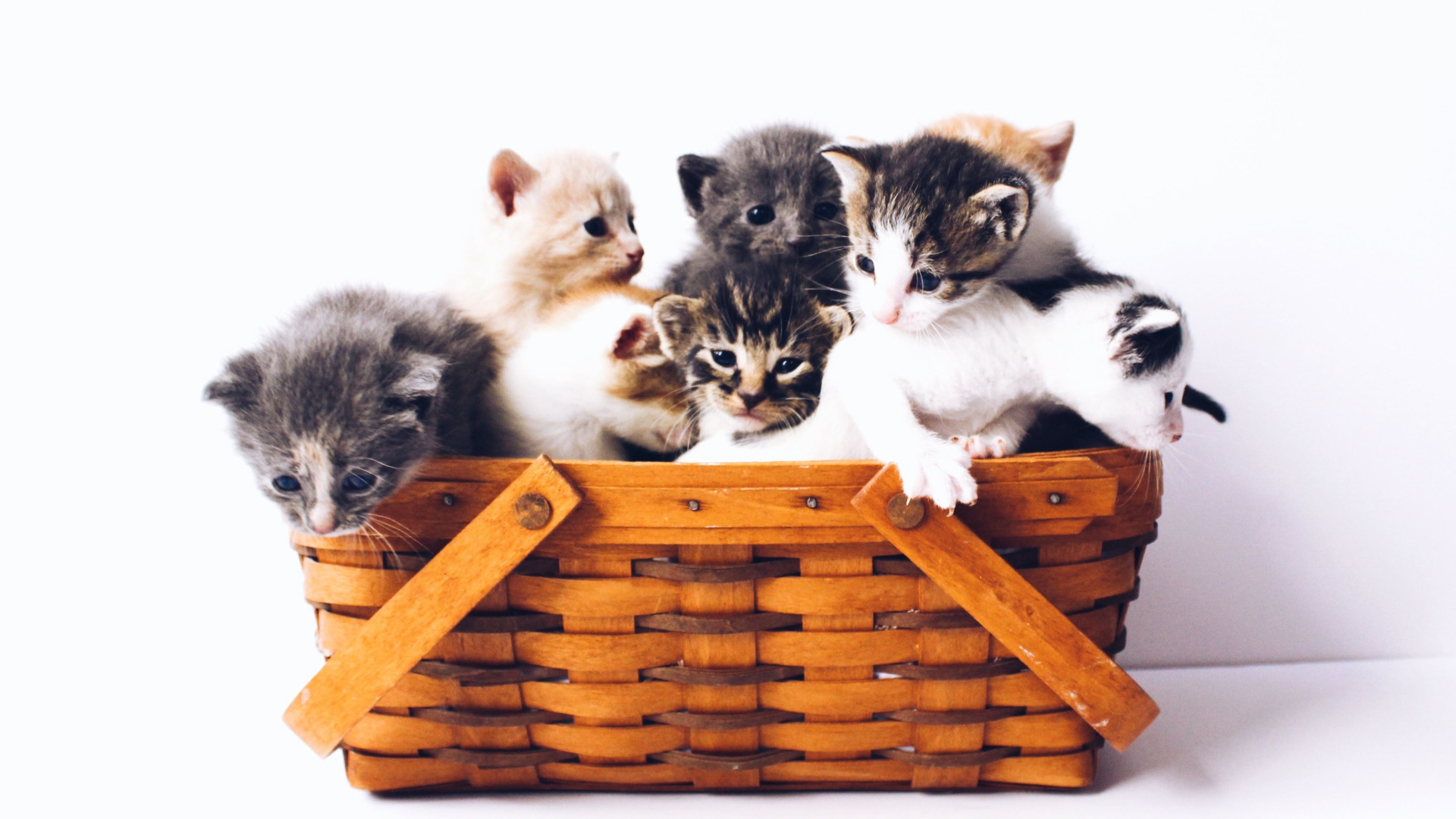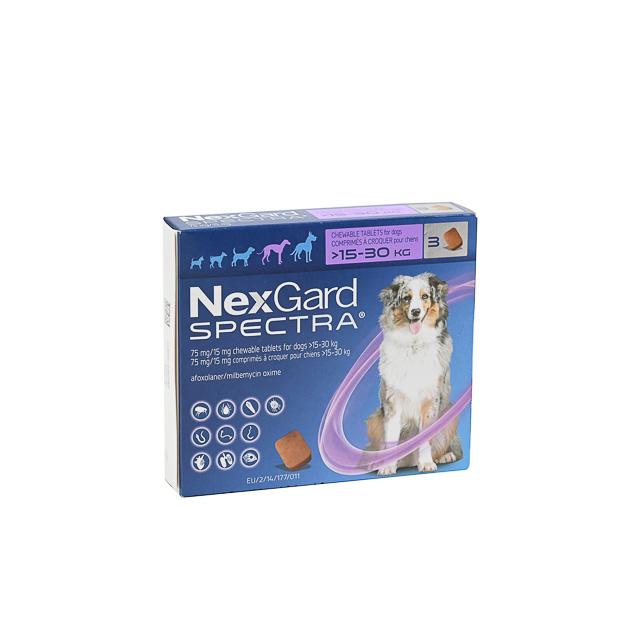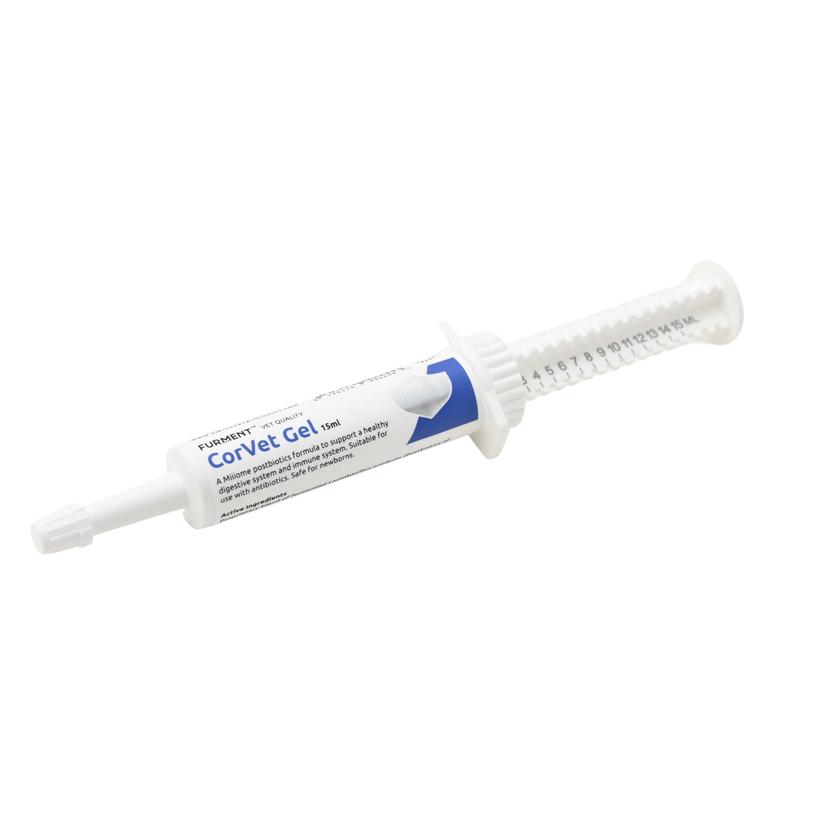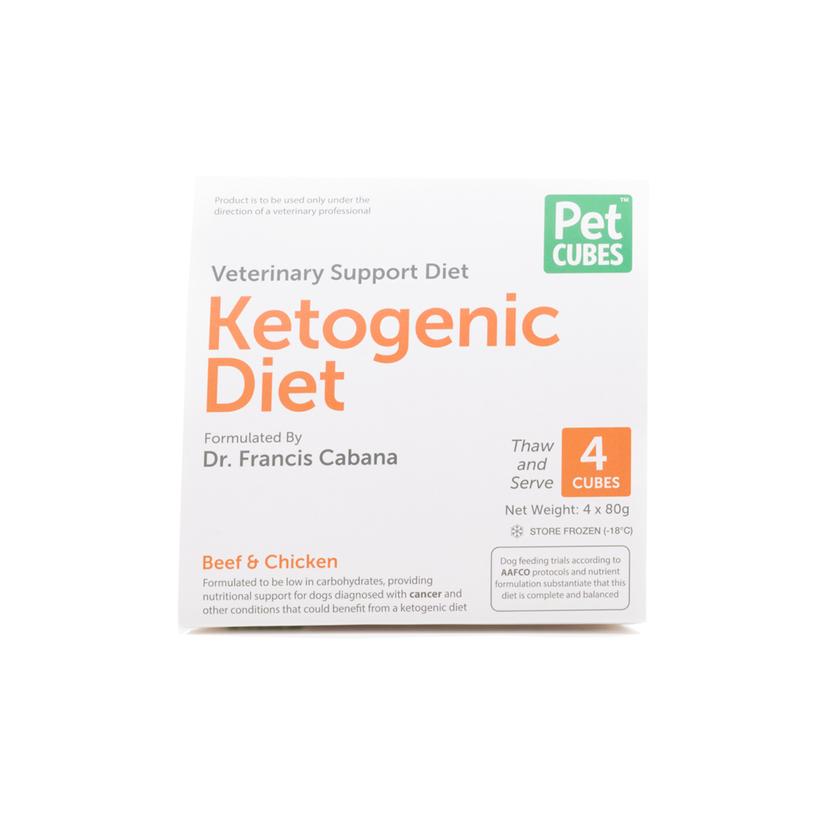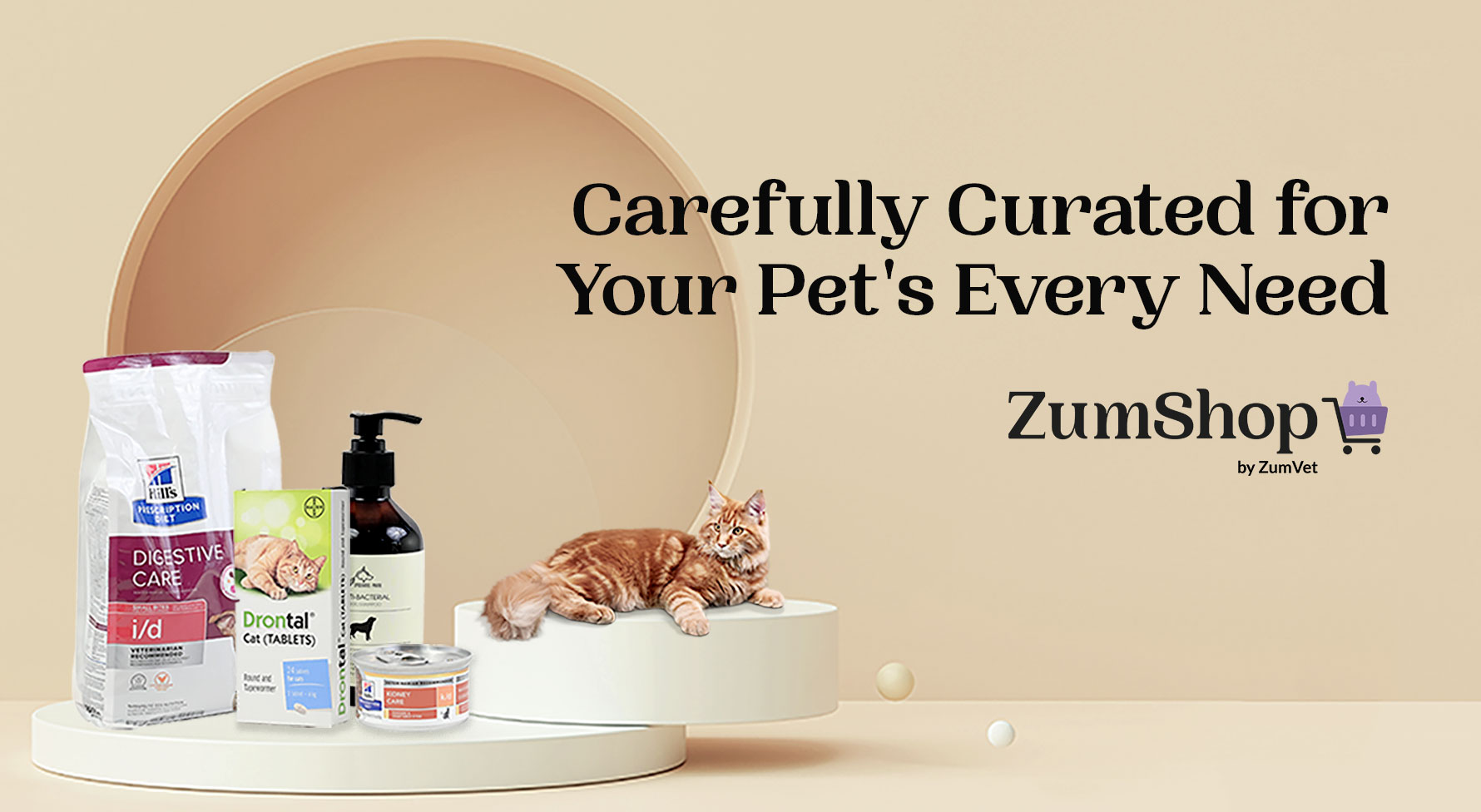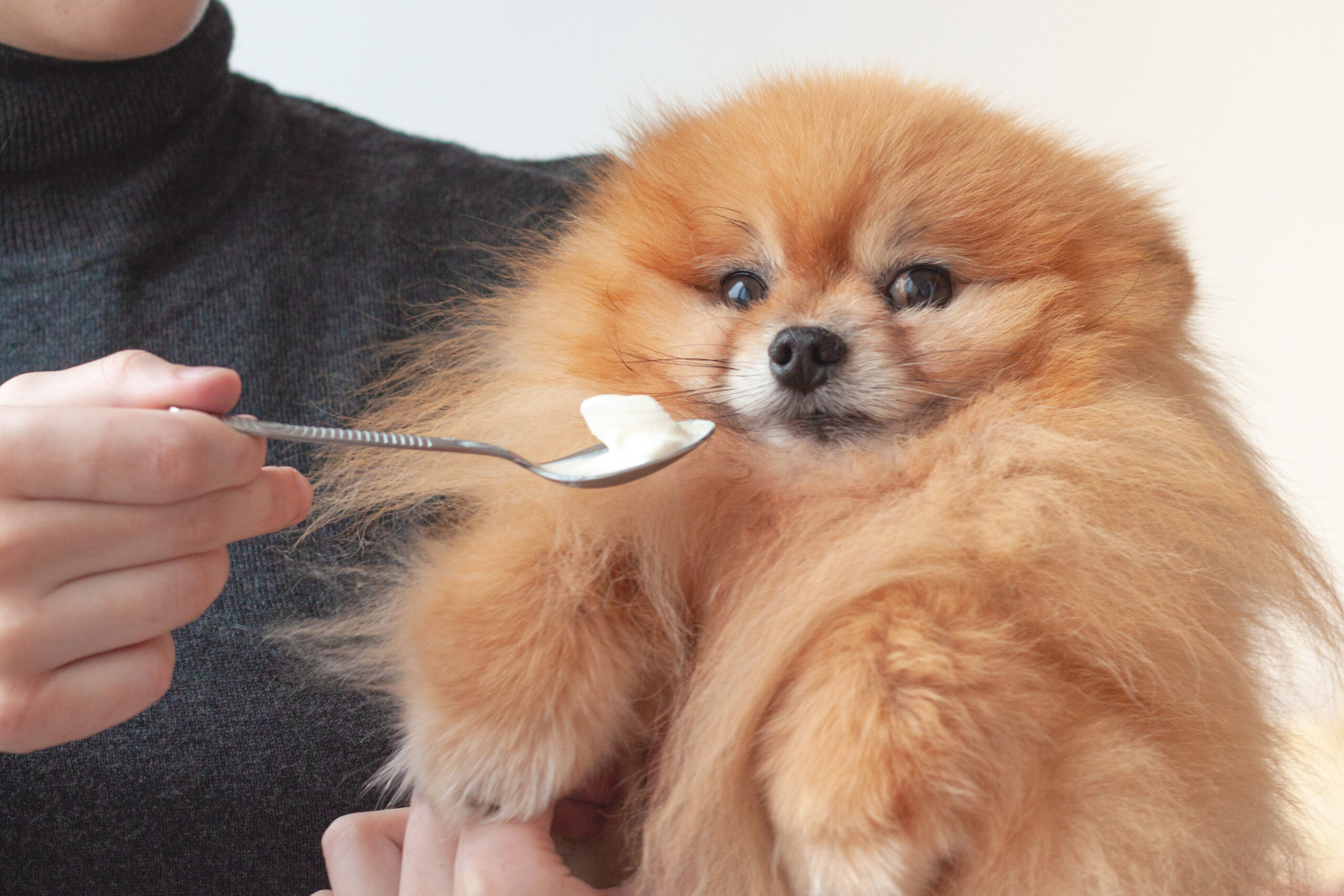Cats are great pets, because they are easy to maintain and train. That being said, choosing the right breed is essential if you want to co-exist with your cat safely and comfortably. Cats differ based on their coat types, vocal ranges and energy levels, and you must consider these factors before bringing a cat into your home. This is especially vital for Singaporeans, who mostly live in apartment complexes that place restrictions on cat ownership.
NOTE- If you are an HDB Flat owner, you cannot legally keep a cat in your house. If an HDB flat owner is caught housing a cat, he/she may be required to rehome the cat as per HDB guidelines. If the homeowner continues to breach HDB guidelines, he/she can be fined up to $4,000. HDB has very strict guidelines when it comes to keeping pets, so if you live in an HDB flat, please go through the guidelines carefully before bringing any animal into your home.
In this article, we will talk about 10 friendly and cuddly cat breeds that can be ideal pets for Singaporeans.
1. Siamese
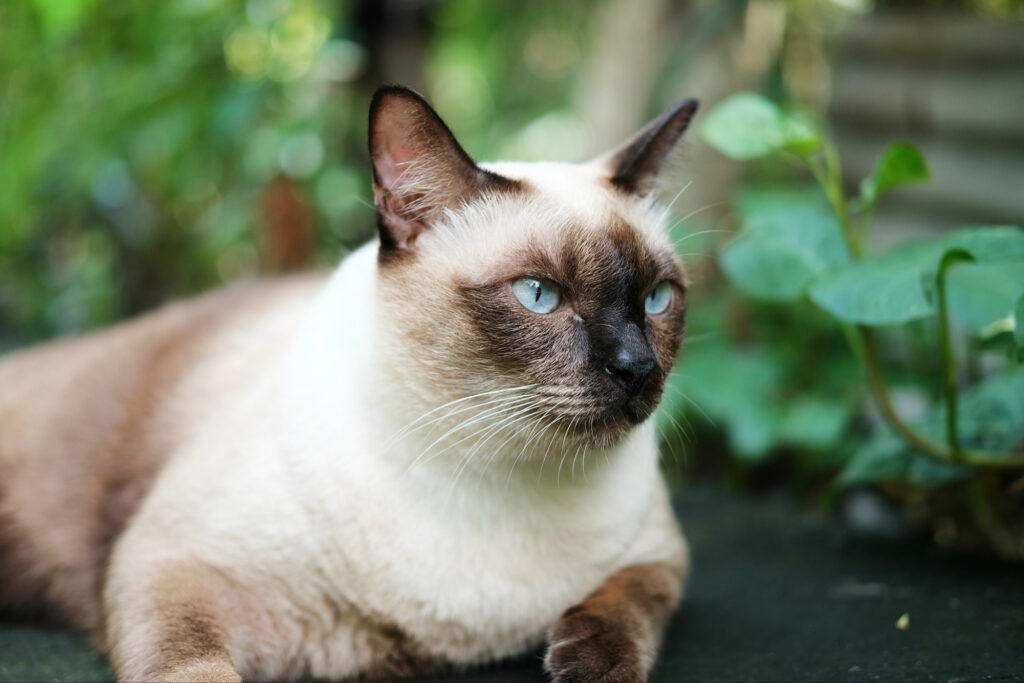
These blue-eyed beauties are highly affectionate, social, playful and intelligent. The Siamese is also known for its graceful features and friendly temperament. This breed has also been used by many different breeders to develop several hybrid cat breeds such as the Himalayan cat.
Modern Siamese Cats are more elongated, lean and tubular when compared to their Thai cousins, and they have thin, tapering tails. But the most striking feature of this breed is its beautiful blue almond-shaped eyes.
Average Adult Weight – 3.5kg to 5.5kg
Average Adult Height – 27 – 31 cm
Coat type – Short and light, with infrequent shedding
Coat colours – Silver-gray, with hints of orange, brown, cream and lilac undertones
Vocal level – Moderate to High
Energy level – Siamese cats are highly energetic in nature. They need constant interaction and mental stimulation to remain healthy. If they are left alone for prolonged periods of time, there might be a risk that they might develop depression symptoms. So, do consider the amount of time you will be able to spend with your Siamese cat before you decide to rear one in your home.

2. Persian
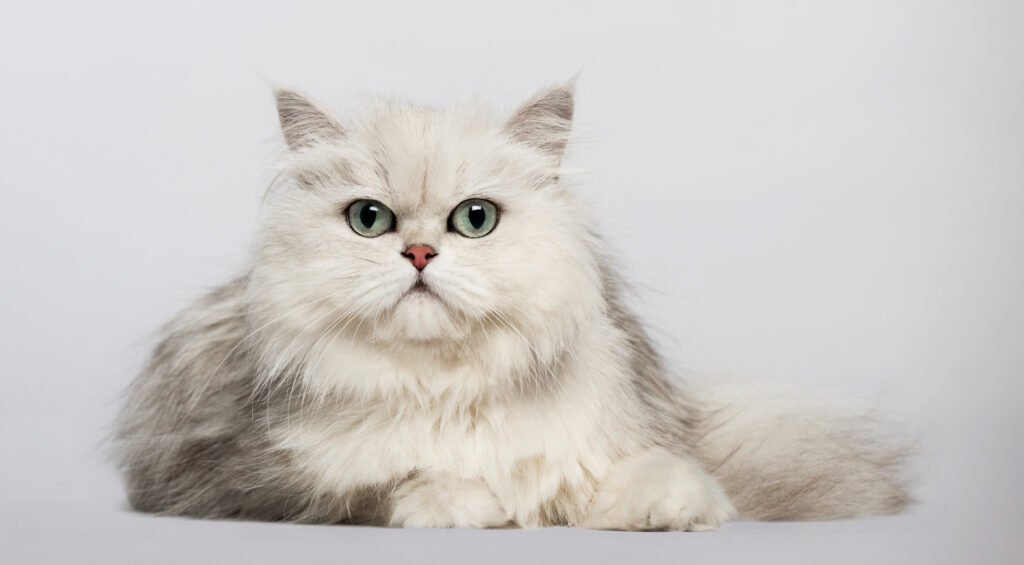
If you want to know which cat breed is most affectionate, then look no further. Persians are one of the most friendly cat breeds. These long-haired cuties have adorable, round faces and short muzzles.
Persian cats originated in Iran and Turkey in the early 1600s, and they have been selectively cross-bred for many generations. If you are looking for a pet that could probably provide you with a pleasurable caressing experience, the Persians are a great alternative to consider.
Average Adult Weight – 2.4kg to 4.7kg.
Average Adult Height – 20-25 cm
Coat type – Long and thick, with a wooly undercoat and frequent shedding in warmer climates
Coat colours – White, black, blue, red, cream, chocolate, and lilac, with tabby, ‘shaded and smoke’ or calico patterns
Vocal level – Low to Moderate
Energy level – Persian cats are very gentle, relaxed and easy-going. There is no need to play with them very often, and they are generally content with regular meals and grooming. They are also a little shy, so don’t expect them to bond easily with guests and strangers. Once they are familiar with everyone in their surroundings, they can become highly affectionate.
3. Singapura Cat

The Singapura is a cat breed Singapore locals have seen everywhere. Whilst the origin story of these cats is unknown, these felines were originally strays that used to live in Singapore’s stormwater drains and gutters.
Singapuras are widely considered as the smallest domesticated cat breed, and they have beautiful deep-cupped ears and almond-shaped eyes.
Fun fact – Did you know that there are 3 Singapura cat sculptures along the Singapore River (Clue: it’s beside Cavanagh Bridge) created by a mystery sculptor still not known today.

Average Adult Weight – 1.8kg to 3.6kg.
Average Adult Height – 15-20 cm
Coat type – Short and fine coats, with infrequent shedding
Coat colours – Cream or beige coats with a dark brown ticking
Vocal level – Low to Moderate
Energy level – Singapura cats usually have moderate to high energy levels. Whilst they are not very hyperactive, they are very interactive and intelligent. Singapuras are known to give headbutts as a sign of affection, and they are very curious when it comes to exploring their surroundings.
4. Bengal Cat
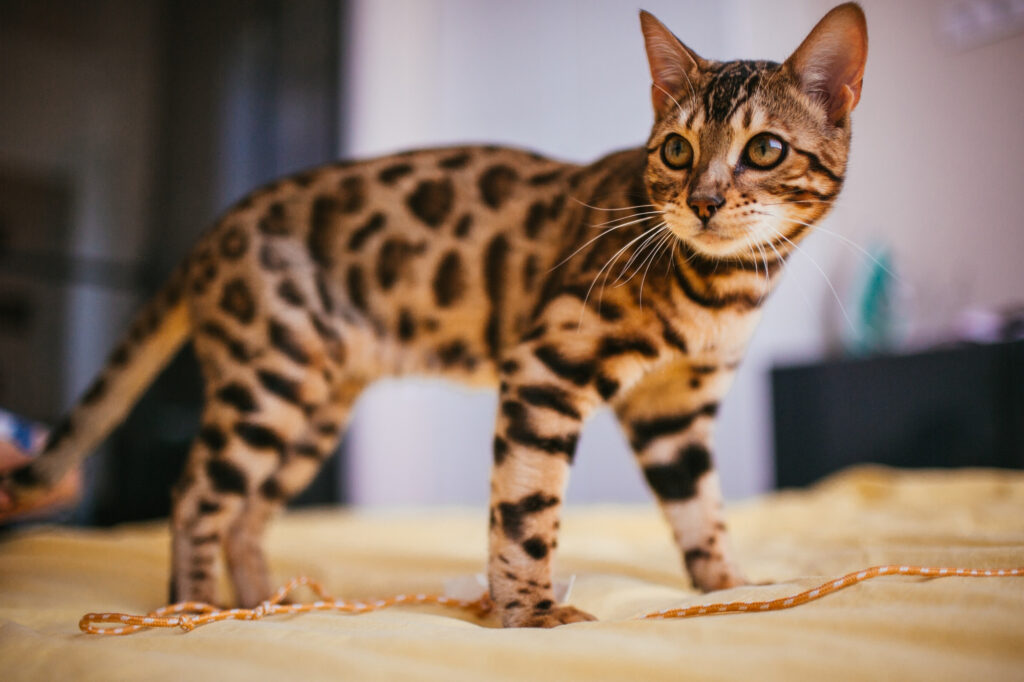
If you are looking for a playful feline companion, then Bengal cats are perfect for you. Bengals have been created by cross-breeding Asian leopard cats and domesticated spotted cats.
Not only are these creatures beautiful and elegant, they are also smart. Bengals are also excellent swimmers and they love splashing around in pools of water.
Average Adult Weight – 3.6kg to 6.8kg.
Average Adult Height – 35-38 cm
Coat type – Short and fine coats, with infrequent shedding
Coat colours – Brown and beige coats, with tabby markings or rosettes that resemble wild leopard cats
Vocal level – Moderate to High
Energy level – Bengals are highly energetic and playful. They are very easy to train and they need constant stimulation to keep their brains engaged. If you are getting a Bengal cat, be prepared to engage them with several hours of playtime frequently.

Pro Tip
Bengals are excellent climbers and they love resting on high perches. Scratching posts or structures that are taller with built-in interactive features could serve as the perfect companion for them if you happen to be busy! If they happen to be tired after hours of playing, a contemporary cat hammock could also be ideal for your pet cat to relax in style.
5. Burmese Cats

Burmese cats are some of the most energetic breeds out there. Some even associated their energy levels to be on par with puppies! As the name suggests, these cats have originated from Burma, but they have actually been cross-bred extensively by American and European breeders from the 1930s to the 1950s.
Burmese cats are social and affectionate, and they bond very well with humans. Burmese cats are also very outgoing and fearless, which is why they shouldn’t be allowed to leave their humble abodes without proper supervision.
Average Adult Weight – 4kg to 5.5kg.
Average Adult Height – 25 – 30 cm
Coat type – Short and glossy coats, with infrequent shedding.
Coat colours – Blue, sable, platinum, lilac, red and brown.
Vocal level – Moderate to High
Energy level – Burmese cats have extremely high energy levels, and their activity levels increase dramatically when they are around people. If you want an active pet that you can play fetch, tag and hide & seek with, then Burmese cats are perfect for you.
6. British Shorthair
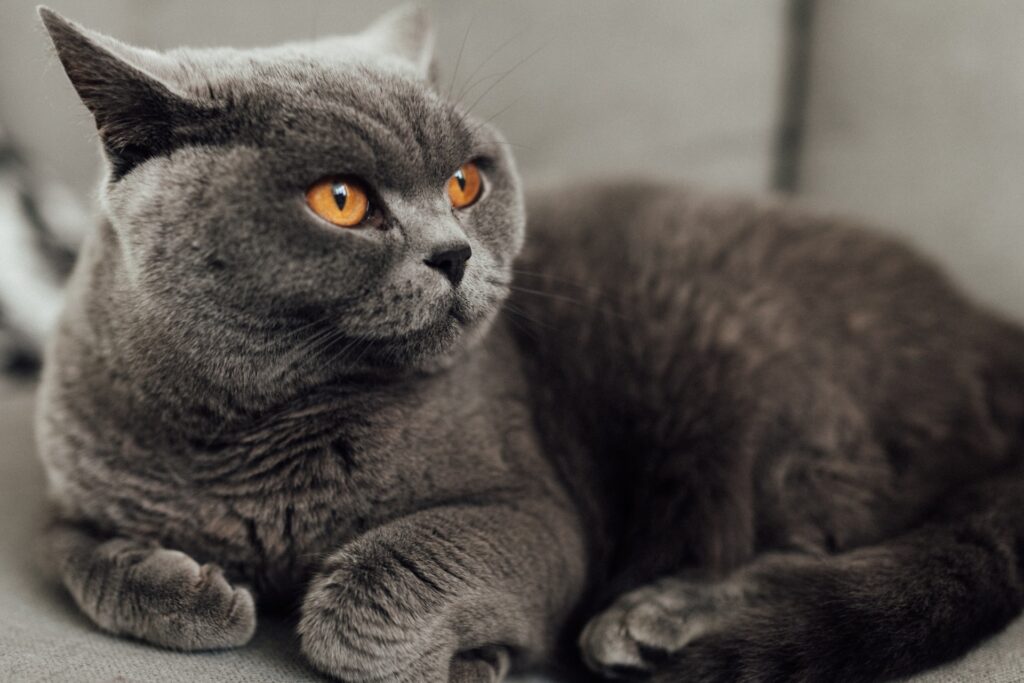
This adorable breed has turned many cat haters into kitty lovers. The British Shorthair is actually one of the oldest domesticated cat breeds and are known to have been selectively bred by Romans since the first century AD.
These furballs have pointy ears and round faces. One of the defining features of the British Shorthair is its smile, which is popularly known as the ‘Cheshire Cat Smile’. This lovable breed is perfect for you if you want a pet that is calm and gentle.
Average Adult Weight – 3kg to 8kg.
Average Adult Height – 30 – 35 cm
Coat type – Thick, dense, short and wooly, with moderate shedding during autumn and spring months.
Coat colours – Black, blue, white, red, cream, silver, golden and lilac, with tabby, shaded or bicolor patterns
Vocal level – Low to Moderate
Energy level – British Shorthairs are not very active or playful, but they are generally accommodative when it comes to physical interactions. They aren’t good lap cats and they usually prefer to sit next to someone. They are great indoor pets because they are not needy by nature, hence they can be left alone for a few hours without any issues.

Pro Tip
As British Shorthairs tend to be less active than other cat breeds, they might risk experiencing unhealthy weight gains if their diets are not managed properly. On the flip side, there are some variants that could be genetically prone to hyperthyroidism – common signs include having unexplained weight loss despite a large appetite, changes in behaviour (vocalisation, aggression), drinking and urination frequencies, etc. It is best to seek professional advice from a qualified vet to check if your furry friend needs a special diet or treatment plan to manage its health issues. If required, the vet could also provide you with a prescription diet to further improve your cat’s weight issues.
7. Maine Coon Cat
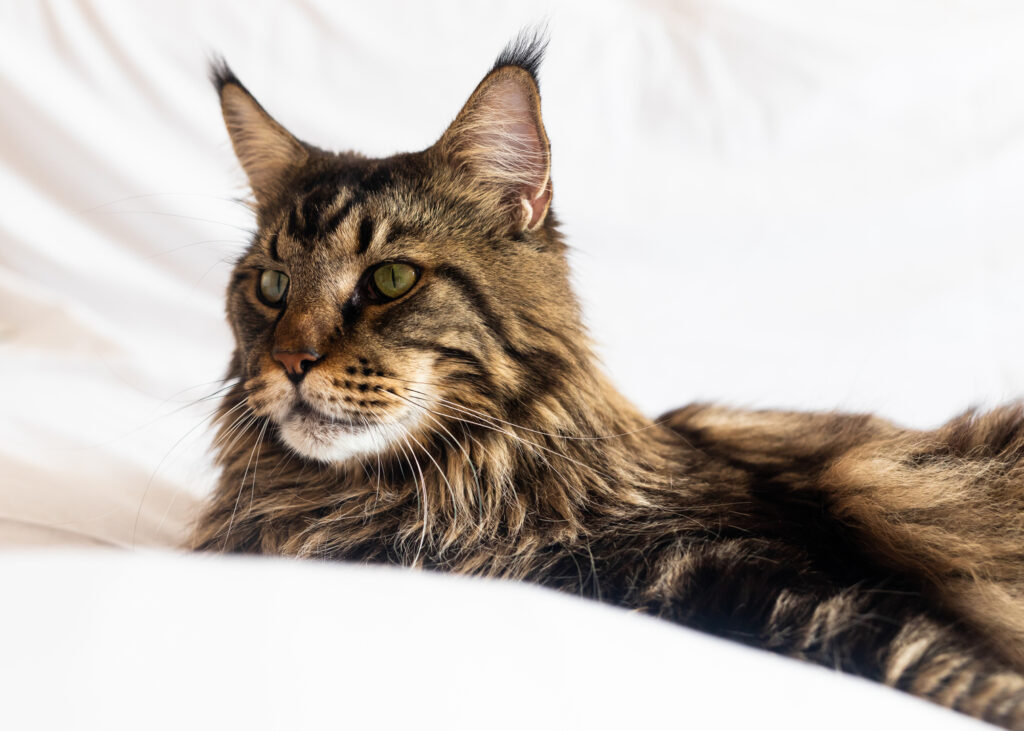
If you have an active lifestyle, then these fluffy beauties will be the perfect addition to your household. While the Maine Coon is an American breed, many cat lovers believe that its ancestry can be traced back to the Norwegian Forest Cat.
Widely regarded as the largest domesticated cat breed, the Maine Coon can be a handful at times, but the breed is generally known to be quite gentle and sweet-tempered.
These felines are known for their furry exterior, which may seem like it is designed for cold weather conditions, but with proper care, they can easily cope with warm weather conditions as well.
Average Adult Weight – 4.5kg to 11.3kg.
Average Adult Height – 38-40 cm
Coat type -Dense and thick undercoat with long guard hairs, with moderate shedding during spring and autumn months.
Coat colours – White, black, red, blue and cream, with tabby, shaded or parti-color patterns.
Vocal level – Moderate to High.
Energy level – Maine Coons are energetic and playful, and they have many dog-like characteristics. It is probably why they are renowned to be highly intelligent and trainable. They are generally comfortable around humans, but tend to be shy around strangers. They might not be the best lap cats but they can be left alone for a few hours without any major issues. They are also very playful when they are placed in bathtub or swimming pools.

Pro Tip
Larger Maine Coons could potentially face health issues such as hip dysplasia and arthritis. Hence, joint supplements should be added to their diets to reduce inflammation and improve mobility. You can visit ZumShop to get vet-approved joint supplements for your cat. You can also book a consultation with a qualified professional on ZumVet if you are unsure about adding a particular supplement to your cat’s diet.
8. Russian Blue
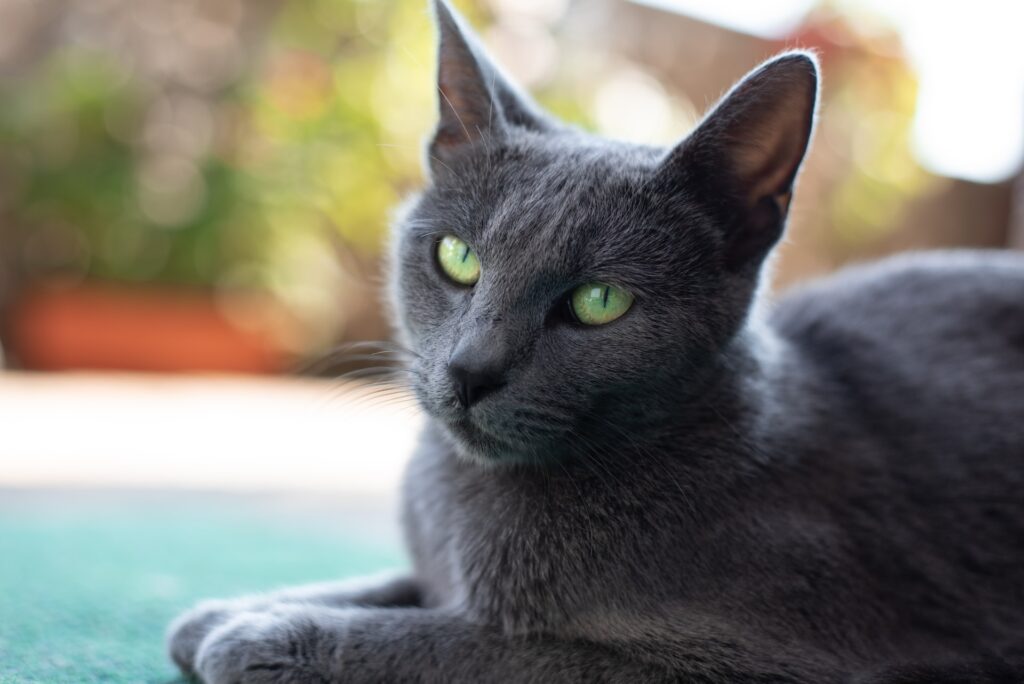
This elegant breed may bring lots of good luck and prosperity into your life. As the name suggests, this breed is said to have originated from Russia, where they are widely considered as good luck charms.
These cats are known for their soft, beautiful coats, so if you enjoy caressing your pets, these charming beauties are perfect for you.
Russian Blues also possess a very sharp memory, and they can remember the people that they interact with quite vividly.
Average Adult Weight – 3kg to 5.5kg.
Average Adult Height – 20-25 cm
Coat type – Soft double coats, with blue or silver tips and infrequent shedding
Coat colours – Blue or grey, some cats may also have white spots
Vocal level – Low to Moderate
Energy level – Russian Blues are very energetic and playful. They have very sharp hunting instincts and appreciate hanging out in the outdoors. These characteristics also enable them to possess exceptional leaping and climbing abilities, and they love hiding their favorite toys. If you are someone who is looking forward to teaching your cat to learn tricks, they can be easily trained to do them as well.

Pro Tip
A Russian Blue’s beautiful fur is definitely a key feature every owner needs to maintain and it can be easily treated with a safe and gentle conditioner. This will help to smoothen and moisturize its fur which will help to retain the fur’s smooth and soft texture.
9. Ragdoll
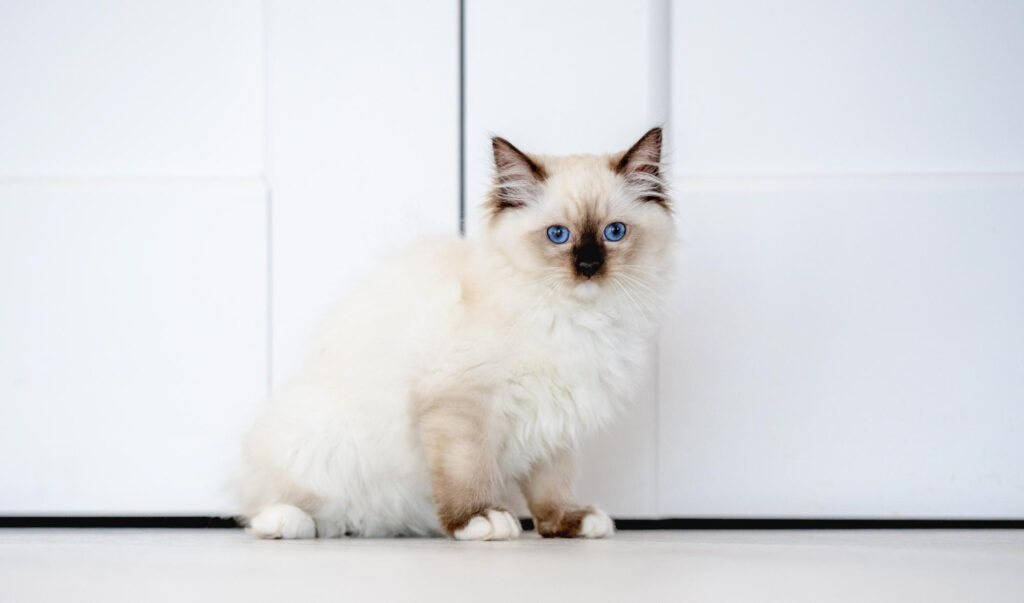
Ragdolls are soft and cuddly felines that are adored by cat-lovers everywhere. This breed is famous for their piercing blue eyes, and they are typically large when compared to other breeds.
Ragdolls were first created by cross-breeding Persian and Burmese cats. Interestingly, these cats are called ‘Ragdolls’ because they tend to go limp and relax whenever they are picked up, just like rag dolls.
They also have unique V-shaped markings on their forehead, which can be in bicolor and tricolor variants.
Average Adult Weight – 3.6kg to 9.1kg.
Average Adult Height – 23-28 cm
Coat type – Silky and dense, with long guard hair and moderate shedding during spring months.
Coat colours – Seal, chocolate, red, blue, lilac and cream colored coats, with bicolor, tricolor, colorpoint and mitted patterns.
Vocal level – Low to Moderate
Energy level – Ragdolls are extremely docile, which makes them perfect lap cats. Despite being a calm and relaxed breed, they can be very playful at times. They enjoy human interaction, and they can be trained to play fetch and retrieve toys as well.
10. Abyssinian
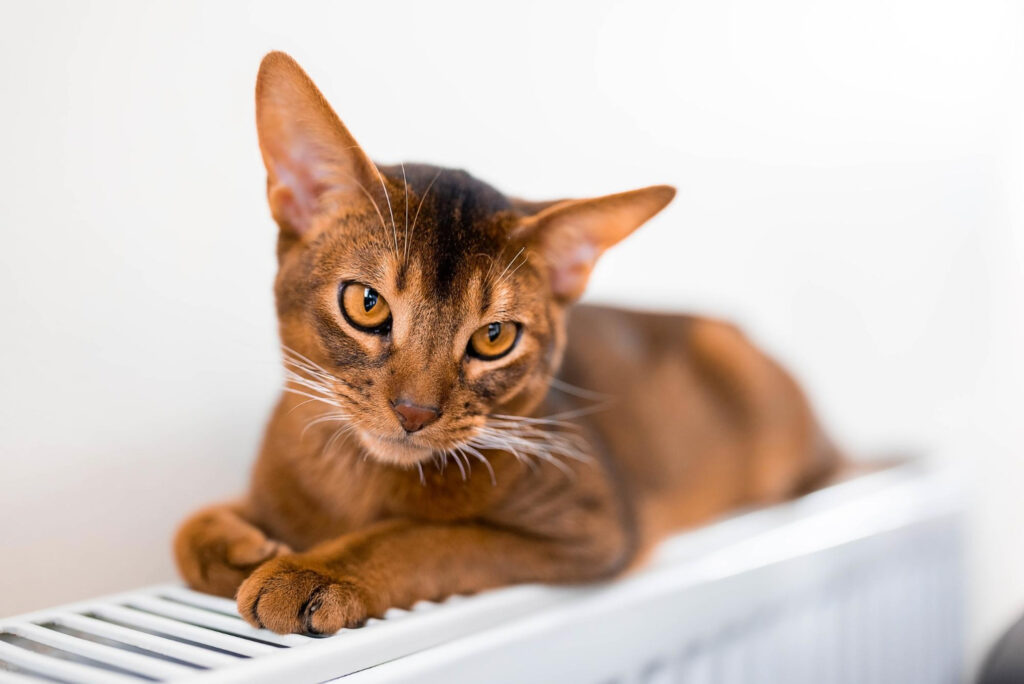
This elegant and exotic breed bears a striking resemblance to the African Wildcat. Popularly known as “Abys”, Abyssinians were thought to have originated from Ethiopia, but recent studies have shown that the breed was brought to Europe by traders traveling through Southeast Asia.
These slender beauties are often called the ‘fashion models of the cat world’ due to their lean bodies and long legs, and they are highly intelligent and inquisitive felines.
Some might confuse the Abyssinian with the Singapura as they might look similar. In actual fact, Singapuras are typically smaller than Abyssinians.
Average Adult Weight- 3.6kg to 5.5kg.
Average Adult Height – 20-30 cm
Coat type – Short and dense, with infrequent shedding
Coat colours – Reddish-brown, silver or cream coats, with black ticking patterns
Vocal level – Moderate to High.
Energy level – If you have an active lifestyle, then the Abyssinian is a great breed to consider as they are very energetic in nature. Their high level of curiosity differentiates them from other breeds and will encourage you to interact with them. If you are also looking for a friendlier breed, Abyssinians can also be considered due to their highly social nature and they can open up easily to guests as well as strangers.

Pro Tip
Periodontal diseases or gingivitis can be very common among Abyssinians. So, if you are getting one into your home, it is best to ensure that its teeth are getting cleaned regularly. If brushing your cat’s teeth can be a concern to you as a beginner cat owner, consider a vet-approved brushless toothpaste that will safely remove bad breath, plaque, and tartar which should result in lesser resistance from your cat. Without brushing regularly, your cat may also need to go for professional dental scaling and polishing more frequently than other cats that has their teeth brushed regularly.
Best Places to Adopt Cats in Singapore

Many of the cats mentioned above are rescued quite often in Singapore, so you could easily adopt them through animal shelters. The most popular animal shelter in Singapore is SPCA Singapore.
SPCA is a registered animal welfare charity that runs Singapore’s largest community-driven animal clinic and shelter for sick, injured, abused and unwanted animals. SPCA vaccinates, sterlises, deworms and tags all its pets, and it has a comprehensive adoption program that helps you choose a pet that is suitable for you.
If you can’t find your preferred breed at SPCA, you can also contact Causes for Animals Singapore (CAS), Animal Lovers League (ALL), Voices for Animals (VFA) or Oasis Second Chance Animal Shelter (OSCAS).
You can also contact a breeder if you are looking for a thoroughbred pet. Before you deal with any breeder, you must ensure that the breeder is registered with the Cat Fanciers Association (CFA) or The International Cat Association (TICA).
In Singapore, cat breeders must also be licensed by the Animal and Veterinary Service (AVS). You must ensure that your breeder has the necessary certifications to run its operations legally and ethically. Some of the cat breeds mentioned above suffer from hereditary diseases. Hence, medical exams are a must before any form of adoption or purchase.
While the breeds mentioned above are quite friendly and sociable, every cat is different. You may expect a cat to be friendly based on its breed, but it may not be very affectionate for multiple reasons. To build a long-term bond with your animal, patience and respect will be key. So, be sure to shower your furry friend with unconditional love and kindness.
Also, it will be easier to build a strong long-term relationship with your cat if you bring it into your home as a kitten.
Last but not least, cats will still fall sick even during the least expected moment and our team of certified vets at ZumVet will always be here to check them up for you over a professional video call. So, be sure to book an appointment with us, especially when you are unsure about any strange symptoms that have appeared out of the blue.
We wish you the best in embarking your first journey towards cat ownership and we look forward to speaking with you about cat tips and advice with our vets!


